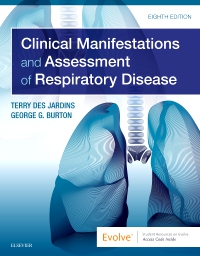
Clinical Manifestations and Assessment of Respiratory Disease Elsevier eBook on VitalSource, 8th Edition
Elsevier eBook on VitalSource

Now $113.04
A realistic look at treating respiratory diseases! Clinical Manifestations and Assessment of Respiratory Disease, 8th Edition gives you a fundamental knowledge and understanding that is required to successfully assess and treat patients with respiratory diseases. Using a unique organization of material, this full-color text is divided into three distinct areas which show you how to first gather clinical data, then formulate assessments, make objective evaluations, identify desired outcomes, design a safe and effective treatment plan, and finally document all steps. With easy-to-follow language and relevant clinical scenarios, you will gain a firm understanding of why certain treatment modalities are applied. New to this edition is a chapter detailing Respiratory Insufficiency in the Patient with Neuro-Respiratory Disease, along with revised content which takes a deeper dive into latest developments, research, and practices and protocols in the treatment of respiratory disease.
Newer Edition Available
Clinical Manifestations and Assessment of Respiratory Disease - Elsevier eBook on VitalSource
-
- Revised content in the disease sections reflect the latest developments, research, and practices and protocols in the treatment of respiratory disease
- UPDATED! Case studies on Evolve provide realistic examples of the respiratory therapist’s role in successful patient care and help you apply text information to clinical assessment and treatment
- UNIQUE! Emphasis on clinical scenarios and critical thinking skills helps students understand the causes of the clinical manifestations activated by specific respiratory disorders
- UNIQUE! Focus on assessment and Therapist-Driven Protocols (TDPs) emphasizes industry-approved standards of care, providing you with the knowledge and skills to implement these protocols into patient care
- Overview boxes summarize the clinical manifestations caused by the pathophysiologic mechanisms of each disorder
- Self-assessment questions at the end of the text help you to personally assess your understanding of chapter material
- Student-friendly features reinforce learning with chapter outlines, objectives, key terms, and easy-to-follow language
-
- NEW! Respiratory Insufficiency in the Patient with Neuro-Respiratory Disease chapter outlines the respiratory therapist’s role in regard to these protocols.
- NEW! Illustrations in designated chapters ensures you have a visual representation of disease processes, and the latest assessment and treatment procedures.
-
PART 1: Assessment of Cardiopulmonary Disease
SECTION I: Bedside Diagnosis
1. The Patient Interview
2. The Physical Examination
3. The Pathophysiologic Basis for Common Clinical Manifestations
SECTION II: CLINICAL DATA OBTAINED FROM LABORATORY TESTS AND SPECIAL PROCEDURES—Objective Findings
4. Pulmonary Function Testing
5. Blood Gas Assessment
6. Assessment of Oxygenation
7. Assessment of the Cardiovascular System
8. Radiologic Examination of the Chest
9. Other Important Tests and Procedures
SECTION III: THE THERAPIST-DRIVEN PROTOCOL PROGRAM—THE ESSENTIALS
10. The Therapist-Driven Protocol Program
11. Respiratory Insufficiency, Respiratory Failure and Ventilatory Management Protocols
12. Recording Skills and Intra-Professional Communication
PART II: Obstructive Lung Disease
13. Chronic Obstructive Pulmonary Disease, Chronic Bronchitis and Emphysema
14. Asthma
15. Cystic Fibrosis
16. Bronchiectasis
PART III: Loss of Alveolar Volume
17. Atelectasis
PART IV: Infectious Pulmonary Disease
18. Pneumonia, Lung Abscess Formation and Important Fungal Diseases
19. Tuberculosis
PART V: Pulmonary Vascular Disease
20. Pulmonary Edema
21. Pulmonary Vascular Disease: Pulmonary Embolism and Pulmonary Hypertension
PART VI: Chest and Pleural Trauma
22. Flail Chest
23. Pneumothorax
PART VII: Disorders of the Pleura and of the Chest Wall
24. Pleural Effusion and Empyema
25. Kyphoscoliosis
PART VIII: Lung Cancer
26. Cancer of the Lung: Prevention and Palliation
PART IX: Environmental Lung Diseases
27. Interstitial Lung Diseases
PART X: Diffuse Alveolar Disease
28. Acute Respiratory Distress Syndrome
PART XI: Neuro-Respiratory Disorders
29. Guillain-Barre Syndrome
30. Myasthenia Gravis
31. Respiratory Insufficiency in the Patient with Neuro-Respiratory Disease
PART XII: Sleep-Related Breathing Disorders
32. Sleep Apnea
PART XIII: Newborn and Early Childhood Cardiopulmonary Disorders
33. The Newborn Disorders
34. Pediatric Assessment, Protocols, and PALS Management
35. Meconium Aspiration Syndrome
36. Transient Tachypnea of the Newborn
37. Respiratory Distress Syndrome
38. Pulmonary Air Leak Syndrome
39. Respiratory Syncytial Virus Infection (Bronchiolitis)
40. Chronic Lung Disease of Infancy
41. Congenital Diaphragmatic Hernia
42. Congenital Heart Disease
43. Croup and Croup-like Syndromes: Laryngotracheobronchitis, Bacterial Tracheitis and Acute Epiglottitis
PART XIV: Other Important Topics
44. Near Drowning/Wet Drowning
45. Smoke Inhalation, Thermal Injuries, and Carbon Monoxide IntoxicationTentative (based on current edition)Appendix
1. Symbols and Abbreviations Commonly Used in Respiratory Physiology
2. Agents Used to Treat Bronchospasm and Airway Inflammation
3. Antibiotics
4. Antifungal Agents
5. Mucolytic and Expectorant Agents
6. Positive Inotropes and Vasopressors
7. Diuretic Agents
8. The Ideal Alveolar Gas Equation
9. Physiologic Dead Space Calculation
10. Units of Measure
11. Poiseuille’s Law
12. PCO2/HCO3_/pH Nomogram
13. Calculated Hemodynamic Measurements
14. DuBois Body Surface Area Chart
15. Cardiopulmonary Profile
16. Answers to Self-Assessment Questions




 as described in our
as described in our 